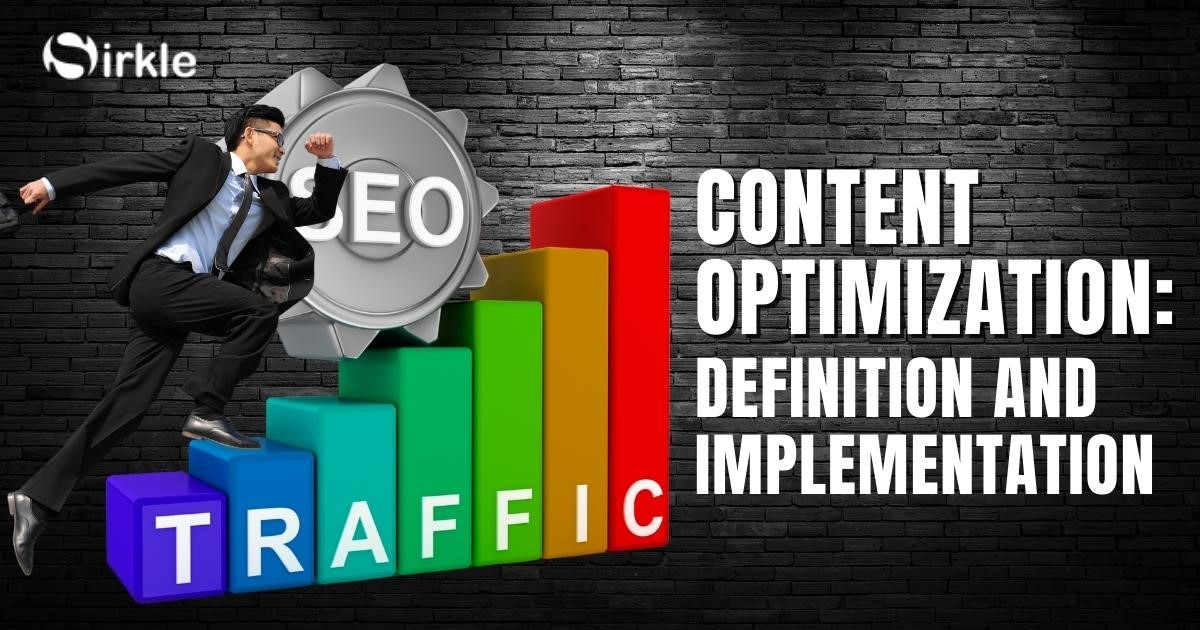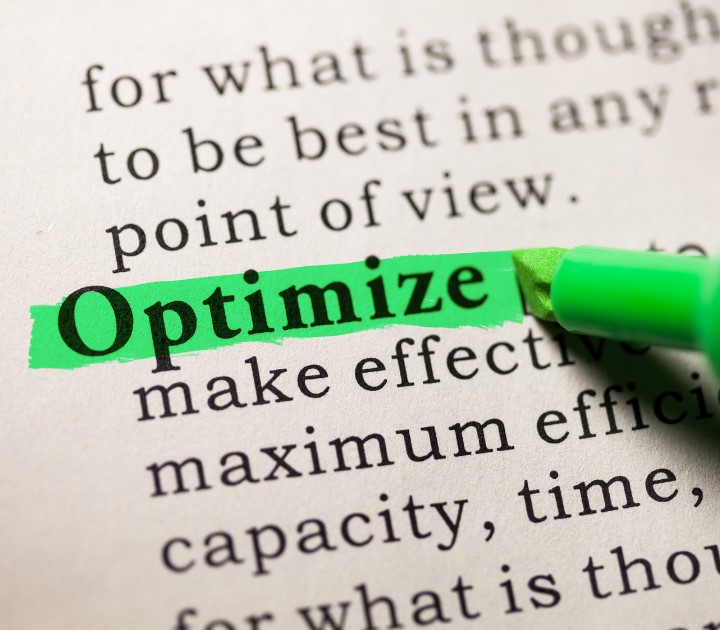Content Optimization: Definition and Implementation

In order for a content marketing strategy to be successful, it needs to include content optimization. Optimizing all types of content marketing, from text-based articles (like this one) to video content marketing campaigns, will make your whole content marketing function successful.
You can optimize content for search engines, otherwise known as SEO, regardless of whether the goal is brand awareness or performance marketing KPIs.

Content optimization - what is it?
Writing, publishing, and building content so that it reaches the largest audience possible is the process of content optimization. As part of the process, keywords, meta and title tags, links, headers, and subheaders, on-site speed, calls-to-action (CTAs), and image size are all considered.
Content Optimization: Why is it Important?
Without content marketing optimization, your audience is unlikely to find your content. You don’t have to send people to find your content directly, as you do on social media, or through ads, but search-based queries are the most powerful way people find it. You will find people and potential customers on your own when you optimize your content for search engines.
Content should be optimized in the following ways:
The position of your website on search engine results pages (SERPs)
- Link earning
- Audience education
- Engage socially
- Generating more leads
- Lead generation at the top of the funnel
- More to come

Content creation vs. content optimization: what's the difference?
Readers read content, machines optimize content.
Providing valuable information to your audience should be your north star when creating content.
It's important that the way you present that information appeals to the algorithms that surface your content to the audience it's meant to reach in the first place. Search algorithms will rank highly optimized content higher on search results than non-optimized content.
The process of optimizing content
A content optimization strategy involves making changes to your content's copy, structure, and metadata in order to make it more valuable to search engines.
To make an article more search engine friendly, bold section titles or tag them as headings (h2, h3, h4, etc.) is one way to separate it into sections.
The visibility of your content can be increased by making small tweaks like this one.
Content Optimization
The key to optimizing your content is to consider several factors, including text, images, and social sharing, as well as new strategies that we will cover in detail.
To reach your goal, you must first define it, and research how to reach it.
In the case of pet food companies, for example, if they are looking to rank for "healthy dog food", which is searched for 10K - 100K times per month on average, they should ask themselves before they begin writing:
- Try searching for this keyword yourself, and see what other people have deemed relevant by looking at competing articles.
- Have you got better information, an unusual perspective, or unseen data that can supplement the current content that's ranking for the term?
- Can you create video content, photo galleries, infographics, or text-based articles?
You can use the following list to optimize your initial piece after you've drafted it once you have answered these three basic questions.

Text optimization
When it comes to improving your rank for a specific keyword, the copy on your page itself goes a long way.
1. Make your content stand out
You don't get to the top of the search engines without writing high-quality content. I break down how to write good content here , but the best way to illustrate what you shouldn't do is to demonstrate what you shouldn't do.
The target keyword was used five times in two sentences, which is a bad practice known as keyword stuffing.
They are transparent about selling themselves in the article that ranks for this keyword, as it contains new research, and clearly outlines their top choices.
2. We'll keep you updated
The fresher your content is, the better your search ranking will be. If you consistently publish new content, your site is more likely to rank higher.
It's also helpful to update older content, so it's still relevant and fresh-just tell search engines that the content has been updated. We do this at Taboola by including the originally published date and the latest update date on each blog post:
3. Tag optimization for the title
Each search result has a title tag that tells search engines what your web page is about.
Among search authorities, Moz recommends a keyword phrase of between 50 and 60 characters long, formulated as follows: Primary Keyword - Secondary Keyword - Brand Name.
In my search for 'hiking snacks', I came across the following examples.
Here are some tools you can use to test your title tag:
- Search Engine Preview Tool for Google SERPs: Smart Search Marketing
- Meta Title Checkup for SEO Sites
- Optimize title tags with Rever Online
The title tag, otherwise known as the H1 tag, does not have to match the title of your article or website.
4. Tag optimization for the H1
H1 tags provide search engines with information about the content on your web page's heading.
Essentially, header tags are code snippets that tell your website how to display content. As the size of your content gets smaller, header tags nest beneath each other. For search engines to determine what your content is about, the H1 tag is the most important.
Here are some rules for good H1 tags:
- The title should match the page title or be barely different
- Keywords should be included
- A single use per page is allowed
5. The H2 tag has been optimized
Usually appearing as the main section headers of an article or webpage, the H2 tag is the next level heading after the H1.
The H2 tag works pretty much the same way as the H1 tag except for one thing: don't overuse them. They should always convey useful information to your audience.
6. The meta description of your website has been optimized
In search engines, the meta description appears below the title tag.
According to Moz, they should be between 155-160 characters in length and adequately describe the webpage they lead to.
If possible, include emojis in your meta description. Think of it as an ad for your site.
Listed below are examples of cheap pens I found using the keyword.
Here are some tools you can use to test your meta description:
- Tool for previewing SERPs
- Snippet Generator at SERPsim.com
7. The first paragraph should contain the target keyword
A relevant and natural way of introducing your piece of content's target keyword should be in the first paragraph.
8. URLs optimized for search engines
It should be straightforward and meaningful, while including appropriate keywords, as it provides search engines with descriptive information about your content.
As a result, your URL and article title may differ.

Image optimization
In the same way as copy, images should first and foremost be valuable and engaging to your audience. They can't speak to algorithms, but they can speak to people.
For search engines to notice them, they should be properly tagged once they've been selected.
1. Tags for alternative text
There are three types of alt tags: 'alt text,' 'alt attributes,' and 'alt descriptions.' These describe your image's purpose or appearance, so search engines can understand what your image is about.
It is also important not to stuff keywords into alt tags - they should accurately and sufficiently describe the image.
2. Tags for images
A user can understand an image's context by referring to the image tags when hovering over it.
Using this code, we can create the following image: title="homemade spaghetti with meat sauce" alt="platter of spaghetti with homemade meat sauce topped with melted asiago cheese" img src="pasta.jpg"/>.
Keyword stuffing is not acceptable for alt text, but it should contain relevant keywords.

Video optimization
Besides finding articles, search engines can also find videos, such as YouTube, Vimeo, and Dailymotion. YouTube is the world's largest video site, but other sites such as Vimeo and Dailymotion are also search engine-friendly.
Your video content description matters for search engine visibility just as it does for images, but engagement is the most important signal for video search engines.
Providing valuable content to your readers is always more important than optimizing it for search engines.
1. Titles of videos
Search engines use your video title to determine whether or not your video is relevant to a person's search query. Make sure your keyword is naturally incorporated into the title so you're more likely to be found.
2. Descriptions of videos
A video description is essentially the video equivalent of a meta description. It should include your target search keyword, accurately describe the video content, and give people a reason to click on it.
Don't forget that they're the ones who determine which video people watch-they're your front line.
My search term is not included in the second recommendation description, although it is included in the title. This is notably video content from a verified contributor, likely highly engaging.
3. Optimization of the site
In addition to being beneficial for SEO, hosting your own videos allows you to collect more video rich snippets for your domain, customize your video player, as well as build backlinks.
For clarification, a video rich snippet is the video equivalent to a title tag and meta description in a copy-based article. For example, I searched for “how to do a pushup” and found:
YouTube videos ranked at the top—in fact, there is some controversy over whether or not YouTube content is prioritized—but clicking on the “More videos...” button at the bottom led to results from other sites: Optimize the video content you host for search queries by following the following tips:
- You can use text or photos to accompany other media types on the page.
- The maximum number of videos should be one.
- Embed it so that others can use it
- If you are using video files, you need to create a CNAME for them
- Iframes shouldn't be used as embedding tools -- instead, use HTML5, Javascript, or Flash
- Share buttons on social media
- Using tools like Slickplan's visual sitemap generator, you can create a video sitemap and submit it to Google (via Google Search Console) and other search engines.
- Google and other search engines should be informed about your video sitemap
Make social media a part of your content marketing strategy
You should build relationships with other users, interact with them, and build a high quantity of social signals, or human interaction metrics, in order to rank well in search engines. Posting the link alone doesn't suffice-you need to build relationships, interact with them, and build a high amount of social signals.

Linked sites
How well your content ranks for certain keywords has a lot to do with whether or not other people find it valuable, and one way search engines decide whether or not your content is valuable to other people is based on the number of links you include in it, to it and away from it, as well as the value of those links.
1. Away from home
It's an outbound link when others link to your site and you link back to them. The more authoritative the site that links to you, the better.
Whenever you link to another site, keep these best practices in mind:
- Links should only be included if they are relevant to your content and provide the reader with value
- Nofollow links are used when linking to non-authoritative sites. They are coded as: a href="" rel="nofollow">TEXT/a>
- Using Moz's link explorer, you can see who is linking to your site
- Make sure anchor text is relevant and descriptive
When seeking links from other sites, keep these best practices in mind:
- Make good content that people want to reference and link to
- Find authoritative pages to link to
- The more backlinks you have, the better
- Follows and nofollows should be balanced
- Make sure your site is linked to by high-quality sites
For more information on link building, take a look at Mo's deep dive.
2. Links within the site
A strategic linking strategy between your own site's pages can help you rank better in search engines, while linking to and from other websites can help you rank higher as well.
Whenever you link to another article on your site, try to keep the mind of the reader in mind. If they read article A, what other content would they be looking for? Use this idea as a guide for linking to articles B, C, D, and so on.
To start linking internally, follow these steps:
- Identify the buyer's journey of the user
- This example from Coggle.it shows how you can map your website pages based on the user journey:
- The main pillar pages at the top of the mind map should be linked to the subpages that you have mapped in groups.
Keeping internal links 'clean' involves keeping the following in mind:
- Plugins shouldn't be used
- 'Mega' menus are not for you
- Linking automatically should never be used
- Maintain a list of broken links
You can go deeper into this topic with SEMRush's guide to internal linking.
Layout designed for mobile devices
Your website's visibility on search engines depends on whether your website has been optimized for mobile traffic, according to Google.
Google released an update to mobile search results in April 2015 that many people referred to as 'mobilegeddon'. If you don't have mobile-friendly pages, your mobile traffic won't see them.
In order to make sure your site is mobile-friendly, keep these best practices in mind:
It is common to have different URLs for desktop and mobile traffic, such as the following:
- Website: brand.com
- Website: m.brand.com
- Display different HTML/CSS code depending on the device using dynamic serving
- Responsive design is essential
A mobile SEO guide from Backlinko explains how to optimize your current site.
- Speed up your website
- It is a well-known fact that 47% of people wait two seconds or less for a page to load before leaving. This is why it is important to make your page load as fast as possible.
- Faster-loading sites are prioritized by search engines.
- Improve your site's speed by following these general guidelines:
- Choose a server that responds quickly
- Don't make your pictures so large that they take forever to load by compressing them
- The HTML and CSS structure of your page should be structured so that the most important items load first
- Make your site files smaller and more efficient by minifying and compressing scripts
- Depending on how frequently your website is updated, you should choose the right cache policy for your website. Caching helps your website load faster when you return to it.
- Plugins should be used as little as possible
Here's a comprehensive guide on site speed from Cognitive SEO.

Buttons for social sharing
By enabling site visitors to share your content via social media, you will boost traffic from those sites. Put social share buttons on your blog or other important pages for best results:
In our blog site, you will find the following buttons at the top of each article:
As you can see, optimizing your content is just as impressive as creating good content, so when you get your audience to find you, it's well worth the effort. Here's how an article on landing page optimization from the Taboola Blog has been optimized to help our audiences find it:
This article shows how multiple SEO tactics can work together to improve search engine visibility in an article, although it doesn't illustrate every recommendation in this post.
Optimizing your content for 2020
As a result of Google's major algorithm update in 2018, new content optimization principles have emerged that emphasize expertise, authority, and trustworthiness.
Rather than focusing on keywords and metadata, today's content optimization aims to ensure that content provides the audience with what they want.
Google's new search visibility requirements can be met by following these six rules.
Create a trusting environment
Creating relevant and valuable content for your audience will help you build trust with them, because your content is there to build trust in the first place.
For building trustworthy content, keep in mind the following best practices:
- Make sure you keep MarketingLand's trustworthy words in mind
- Make sure your claims are backed up with data
- When USG content is relevant, use it
- When appropriate, use case studies
- Show social proof - proof that other people find this content credible by using any type of social proof
Matching Intent
Search engines are used by people to find answers to questions, solve problems, find products, etc. Each time they type a query, they intend to find something.
To ensure that your content fulfills that intent, you must anticipate what it is before writing.
- See what you can find by searching for the keyword yourself
- Compare your website's rank with other pages that have achieved that rank
- By following all of these practices, you will be able to produce better content than theirs
Quality should be created
The phrase quality content has been thrown around so much that you have lost track of what it actually means.
As we just discussed, it is authoritative and matches the user's intent. It also has the following characteristics:
- There are no grammatical or spelling errors
- Narrative that makes sense
- There's no fluff in this piece - it's the right length
- The topic remains the same
- Scannable format makes it easy to read
Authority should be established
Getting to the top of search engine results takes time, which is why SEO experts say it's a 'long game.' Over time, you build authority through a lot of small actions.
A free tool from Ahrefs lets you check the authority of your website.
Establishing website authority consists of the following pillars:
- Maintain a consistent flow of high-quality, trustworthy content that matches users' intent
- Make your website authoritative by inviting authoritative authors
- Other authoritative sites can use your content

Implement call-to-actions
A successful call-to-action (CTA) should clearly direct the user to do something after consuming your content.
- The copy contains inline links
- Whenever a user leaves a site or scrolls a certain amount
- Here's an example of a sidebar CTA:
- Next to the navigation, there are header CTAs
You can review Hubspot's master list of CTA types here.
Engage your audience with visuals
Last, but not least, your site should have engaging visuals. If your content isn't engaging, people will bounce, and your content won't accomplish anything we've talked about today.
There are several ways to create engaging visuals:
- Explaining a complicated subject using moving GIFs
- Data visualization or process infographics
- Illustrations of a point using screenshots or photographs
Lastly,
It's only valuable if people see your content, and search engines are one of the best ways to do that.
- The highlights are as follows:
- Optimize and engage your copy
- Maintain relevant and up-to-date metadata
- Organize your site logically
- Improve the technical performance of your site
- Make sure your videos are optimized
- Remember the EAT principles
You can improve search engine visibility by implementing these content optimization techniques.
Got Questions? Visit our website at https://www.sirkle.com


